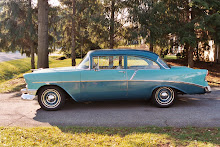It’s hard being a member of a “classic chevy club” and not be concerned about the future of General Motors and those other two car companies. I was born sixty-some years ago and “the big three” (B3) were the big dogs in both American industry and the American economy. In those days they shared the spotlight with biggies in the steel industry and retail giants like Sears-Roebuck. Although quite a few of the companies on the NY Stock Exchange today were there fifty years ago, some are gone (the steel industry and retail giants like Sears-Roebuck) and those that remain have transformed themselves to meet the realities of a new century and a new economy. All except the B3, apparently.
Despite the persistent ringing of their alarms, the B3 seem to insist on hitting the snooze button. How obvious was the wake-up call from Japanese and European automakers every year since the 1960s? Since 1966 the best selling car has been a Toyota followed closely by a Volkswagen. With the exception of the Ford F-150, Mustang and Corvette, niche vehicles at best, the top selling cars for over forty years were built by someone other than the B3. If the reason why American cars have under-performed in the marketplace was a mystery the lack of response on the part of the B3 might be understandable. But there is no mystery, buyers know they get better value buying “foreign” cars!
Today we’re told the B3 are on the verge of collapse and that they need to be bailed-out or they’ll fail and drag the rest of the economy with them. The debate rages; bail-out or bankrupcy and there is plenty of support for either side. I’m a car guy not an economist and, therefore, not qualified to make the decision as to which course should be taken. Following the course they have over the sixty-some years I’ve been around, however, is not working for the B3 and it seems to me the problem is accounting, not economics.
The basis for accounting is balance; matching expenditures to revenue or not spending more than you make. The B3 have not operated within this accounting paradigm in decades. No component of the cost of “building a car” is more out of balance than labor costs (wages and benefits). The B3 are unionized and they pay their employees nearly 50% more than companies like Toyota and Honda pay their employees who build cars in the United States. A drive across Michigan reveals acres of new vehicles in abandoned parking lots, cars that were built in excess of demand because the B3 were required to pay union auto workers whether the cars were needed or not. When airlines started folding under the pressure of expensive labor contracts they re-negotiated those contracts and managed to survive and fly another day.
I don’t have the credentials to propose a solution to the crisis facing the B3 and I wouldn’t want the responsibility to do so if I was qualified. I am conscious, however, which may be more than can be said of the powers-that-be at either the B3 or the United Auto Workers. Albert Einstein said insanity is doing the same thing over and over again and expecting a different result. I believe insanity ought to be ample justification for throwing out the fools who have been running the B3 for decades. They didn’t fix things when it became obvious things were broken in the Seventies and there’s no reason to believe they’ll fix them now!
Carroll G. Anderson
From: Heart of Maryland Classic Chevy Club Holiday 2008 Newsletter
Subscribe to:
Post Comments (Atom)

No comments:
Post a Comment